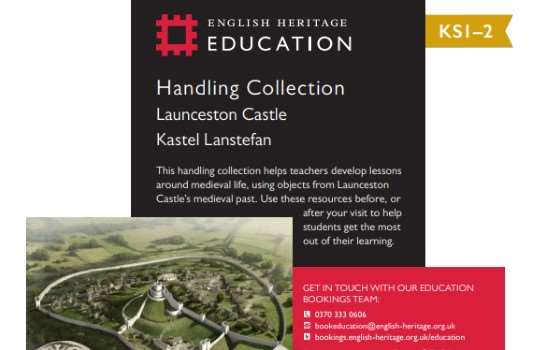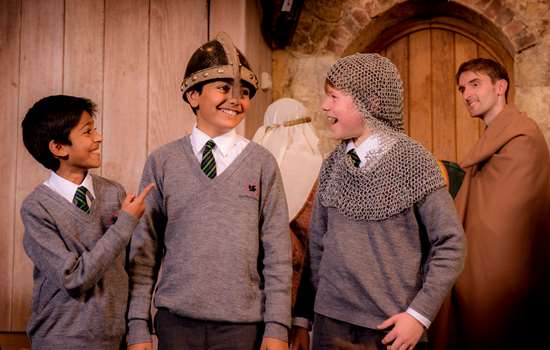Get To Grips With The Area
Launceston Castle was built in a strategically important location; it provides a view for miles around, and controlled the main road into Cornwall during the medieval period, which crossed the Tamar at Polson Bridge. The original castle was built in 1068 by Count Brian of Brittany, a close supporter of William I (r. 1066-1087). It was remodelled in the 1200s by Richard, Earl of Cornwall. Richard valued his Cornish estate because the local tin mining industry made him very wealthy. In 1272, his son Edmund, moved administrative matters from Launceston to Restormel Castle to be closer to the tin industry.
Built on a mound, and with a wall surrounding the castle grounds, Launceston Castle is an example of a motte and bailey castle. The Normans added height to the existing hill and the keep provided an additional vantage point from which to survey the area. Originally constructed from wood, Richard Earl of Cornwall rebuilt the castle from stone, adding a portcullis and thick gates to further strengthen the building.
Despite the castle being built with strong defences in mind, it has had a peaceful existence, only briefly facing conflict during the English Civil Wars.
For a long period in its history, Launceston Castle was court house and a prison. It had three cells for women prisoners and four cells for men. The conditions in the prison were notoriously damp and squalid, and one cell was nicknamed ‘doomsdale.’ Notable prisoners include the Quaker leader George Fox and the Catholic Priest Cuthbert Mayne, who was made a Saint in 1970. Launceston Castle stopped acting as a prison in the 1840s, and was converted into a pleasure garden by the Duke of Northumberland, who owned it at the time.
During World War II, nissen huts were built in the grounds at Launceston Castle. These were field hospitals for the U.S. troops stationed in Cornwall as they trained for the D-Day landings.
Top Resources
-

Launceston Castle Handling Collection Kit (KS1-KS2)
Our Handling Collection Kit features historical information and activity suggestions for group leaders of various subjects and key stages.
-
History At Home Live! Castles
Join Ben Shires and our expert Jeremy Ashbee to develop your understanding of castles and the people that lived in them.
-
How to Take a Medieval Castle
Watch our short animation to learn more about how to take a medieval castle.
-
A Mini Guide to Castles
Discover how castles developed over time with this short introduction.
Link Your Learning
ENGLISH - The work of local poet Charles Causley is featured at Launceston Castle, read and analyse his work and write a poem about the castle.
SCIENCE - Launceston is a medieval castle, which means that there is no electricity. To increase visibility in the dark stairwell, white-wash has been used to help make it easier to see as it reflects more light. Explore how light reflects off different surfaces and what materials can be used to reflect the most light. The museum at Launceston Castle has a cresset lamp on display, which experts think used whale blubber as a fuel. Students can compare and contrast this lamp to modern lamps. Students may also explore the transfer of energy that takes place when fuel is burned.
MATHS - Being on a mound is part of Launceston’s defensive structure, and being high up gives it a tactical advantage during conflict; count the number of steps it takes to reach the upper level of the castle. Try and identify the different shapes you can find at the castle, such as windows and doors.
ART AND DESGIN - The grounds around Launceston Castle were turned into a pleasure garden, design a garden. How would you design a public garden around Launceston today? What key features would you like to see?
GEOGRAPHY - What are the geographical features around Launceston that make it a suitable place for a castle? Using a map of Cornwall, locate Launceston. Then, locate the sites of tin mines in Cornwall, are they close to Launceston or far away? Explore the impact of the tin mining industry on Launceston.
Visiting Launceston Castle
"Launceston Castle’s position right in the centre of the town makes it a local landmark and it can be seen from miles around. You can book a free education visit to really bring local stories to life and take your students back in time! It’s a great way to enrich your students learning and help them understand how and why their community has changed and developed over time, as well as offer valuable opportunities beyond the classroom.
The town grew up around this Norman stronghold and it has played a role in the lives of the local people for many centuries and in many different ways. A visit to the castle can inspire learning in a range of subjects including literacy, drama, geography and maths, as well as history.
We have a free loan box that can be collected from the castle to enhance the classroom learning for your students either before or after a visit to the castle. It includes replica items relevant to the medieval history of the castle and suggested activities. You will also find links on our website to a range of free downloadable resources to further support your students’ learning.
We encourage you to take advantage of a free advance planning visit so can prepare for your trip with confidence. I’m here to support you get the most from your visit and the local learning opportunities, so please do get in touch."
- Helen Kerry, Education Visits Officer (West)
Find Out More



